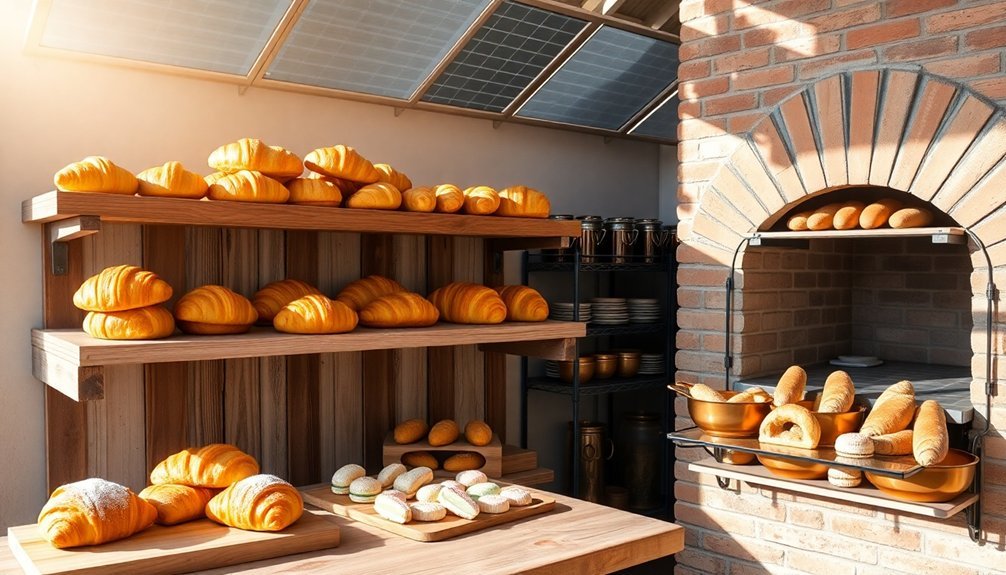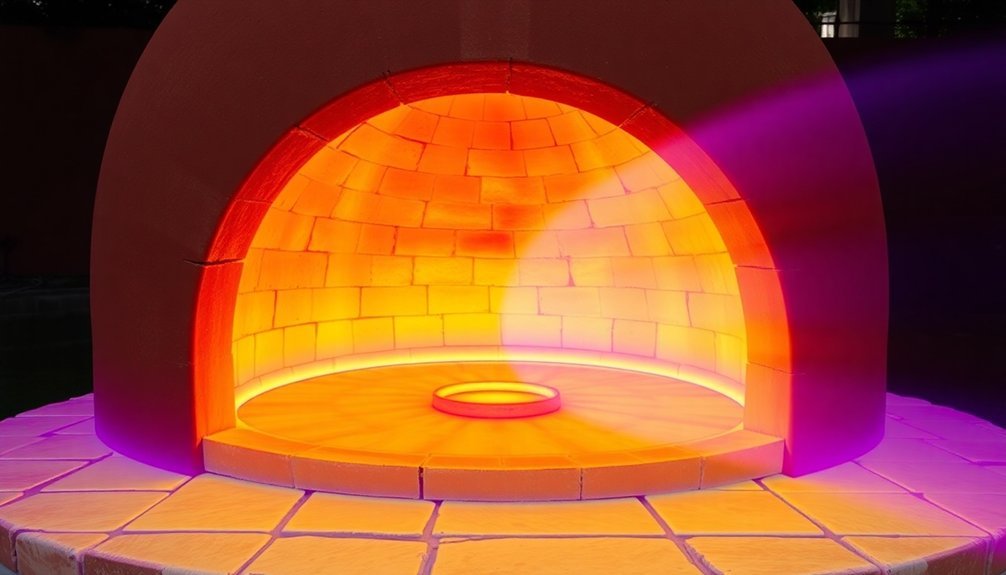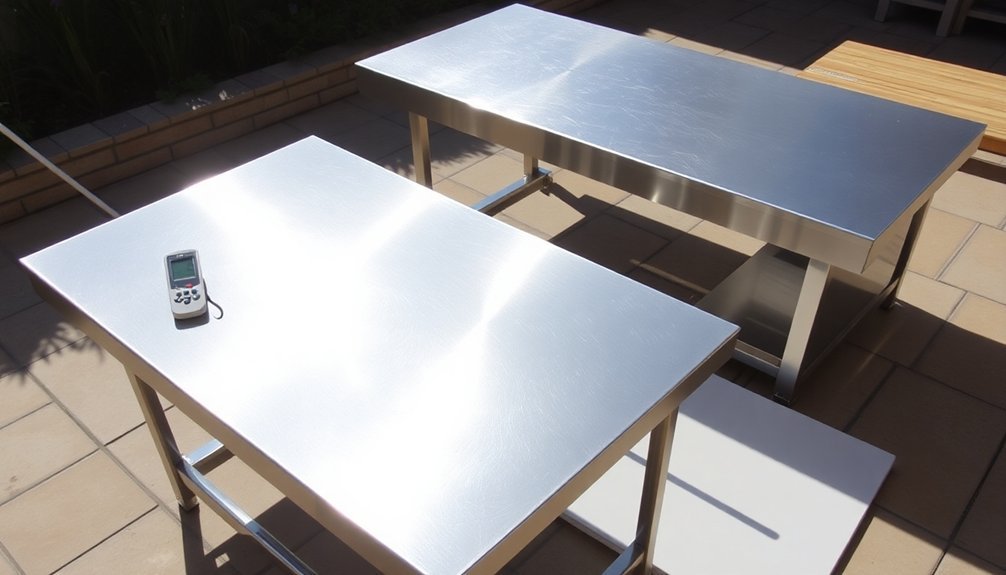For your solar-powered bakery, you'll want to focus on pastries that thrive in the unique conditions of solar ovens. Light and flaky items like apple puff pastry cook beautifully in about 30 minutes during peak sunlight hours (11 AM – 3 PM). S'mores and cheesecakes adapt well to solar baking, taking 90 minutes and 2-2.5 hours respectively. You'll need dark metal pans and proper positioning to maximize heat absorption, along with greaseproof paper to prevent sticking. Using elevated racks guarantees proper air circulation for even baking. The journey to perfect solar pastries involves mastering both timing and technique.
Choosing Your Solar Baking Location

With sunlight as your primary power source, selecting the perfect location for your solar bakery is essential to its success. You'll want to prioritize south-facing areas that receive direct sunlight throughout the day, as these spots maximize your solar energy capture.
Before settling on a location, study the path of the sun and identify any potential obstructions like trees or buildings that could cast shadows on your panels. Following the example of successful operations like Alvarado Street Bakery with their 1,722 photovoltaic panels, you can achieve optimal energy production for your baking needs.
Consider your local climate patterns carefully. Areas with consistent sunshine and minimal cloud cover will provide the most reliable energy for your baking operations. You can boost your solar efficiency by using reflective materials strategically to redirect sunlight where needed.
Don't forget to check local weather data to plan your peak baking hours and seasons.
Your chosen location must also have proper infrastructure and accessibility. Verify you've got enough space for both your panels and baking equipment, while maintaining easy access for maintenance.
Check local zoning laws and building codes before setting up. Additionally, position your bakery where it won't negatively impact the community or environment – this includes considering noise levels, waste management, and potential emissions reduction from your solar setup.
Essential Solar Pastry Equipment
Your solar pastry operation needs durable, heat-resistant tools that can withstand temperatures up to 300 Celsius while producing up to 110 kg of baked goods daily.
Mobile oven racks let you efficiently move your pastries in and out of the solar-powered baking zone, making the most of available sunlight hours. The innovative system developed by Partners With Sun has demonstrated promising results in Lebanese bakeries.
These specialized tools work seamlessly with the silver mirror system and heat exchange mechanism, ensuring you'll get consistent results across your range of pastries, breads, and other baked products.
Heat-Resistant Baking Tools
Four essential heat-resistant tools form the foundation of successful solar pastry baking. You'll need specialized equipment that can withstand temperatures up to 300°F while maintaining your pastries' quality. When selecting your tools, focus on materials that won't warp or release harmful chemicals under intense solar heat. Placing an aluminum foil lining beneath your baking tools helps reflect and retain heat more effectively.
| Tool Type | Temperature Rating | Primary Use |
|---|---|---|
| Dark Metal Pans | Up to 300°F | Heat absorption |
| Glass Containers | Up to 250°F | Heat retention |
| Silicone Mats | Up to 280°F | Non-stick baking |
| Aluminum Trays | Up to 300°F | Heat distribution |
| Metal Racks | Up to 300°F | Air circulation |
To maximize your solar oven's efficiency, you'll want to use dark-colored baking pans that absorb heat effectively. Consider using thermal mass containers, like heat-resistant glass, to maintain consistent temperatures during baking. Don't forget to position your baking tools on elevated racks to guarantee proper air circulation. For best results, line your pans with high-temperature silicone mats, which prevent sticking and make cleaning easier. Remember to adjust your tools periodically to match the sun's position, guaranteeing even heat distribution throughout your baking process.
Mobile Solar Oven Racks
Mobile solar oven racks stand out from among the most essential equipment for outdoor pastry production. When you're choosing racks for your solar-powered bakery, you'll find that different models offer varying capabilities.
The Lytefire Deluxe Oven comes with two professional-grade baking racks that can handle up to 110kg of bread daily, making it ideal for high-volume production.
For smaller operations, the SunFlair Solar Oven's collapsible design includes two portable pots and a specialized baking tray that work perfectly with its lightweight frame. You can enhance your baking setup with Lytefire's optional pastry grid, which provides additional flexibility for different pastry types.
You'll need to evaluate the rack's compatibility with your oven's temperature range. The Lytefire's racks are designed to withstand higher temperatures, while SunFlair's accessories are optimized for temperatures up to 225°F (107°C).
When you're monitoring your bakes, you'll appreciate that both systems include thermometers to help you maintain precise temperature control. The racks' design also takes into account mobility – they're either collapsible or easily dismountable, supporting quick setup and teardown of your outdoor bakery operation.
Best Pastries For Solar Ovens

Designed for eco-conscious bakers, solar ovens provide a unique way to create delicious pastries using the sun's natural energy.
Whether you're using a professional SunGood 360 multi-cooker or a DIY pizza box oven, you'll find that certain pastries work exceptionally well in solar-powered cooking.
Apple puff pastry is an ideal choice for your solar oven. You'll need to cut your puff pastry dough into pieces, add apple slices and cinnamon, then seal the edges and brush with egg yolk. The pastry takes about 30 minutes to bake in prime conditions.
If you're feeling adventurous, you can try baking cheesecakes, which require 2-2.5 hours, or s'mores that cook in about 90 minutes.
To guarantee success, you'll want to preheat your solar oven and place it in a sunny location.
Using greaseproof paper will prevent sticking, and an oven thermometer will help you monitor temperatures.
Remember that solar cooking typically takes longer than conventional methods, so you'll need to plan accordingly.
Once your pastries are done, let them cool completely before serving to achieve the perfect texture.
Solar Baking Temperature Management
Managing temperature in a solar oven requires careful attention to both design and monitoring techniques.
You'll need to enhance your setup by lining a pizza box with aluminum foil and sealing it with clear plastic wrap to create an effective heat trap. Pre-heat your solar oven for 15-20 minutes before baking, and use a thermometer to verify the internal temperature reaches at least 180°F for safe cooking.
Choose dark-colored, thin metal baking dishes to maximize heat absorption and reduce cooking time. If you're using lighter cookware, cover it with a dark towel to improve efficiency.
Keep the oven pointed at the sun, adjusting its position throughout the day to maintain peak temperature.
Key tips for temperature control:
- Monitor your thermometer regularly without opening the oven unnecessarily
- Adjust the reflective foil flap angle as the sun moves
- Use proper insulation with black construction paper and crumpled newspapers
- Keep the oven in a flat, sunny location for consistent heat
- Maintain cleanliness for maximum efficiency and food safety
Timing Your Solar Pastry Production

You'll achieve the best results for your solar pastry production between 11:00 am and 3:00 pm when UV intensity peaks and temperatures soar to ideal baking levels.
Your daily output schedule needs to account for weather conditions, with clear sunny days offering the most reliable baking windows for consistent pastry production.
To maximize your bakery's efficiency, start preheating your solar oven by 10:00 am and plan your production schedule around peak sun hours while keeping a close eye on weather forecasts.
Peak Sun Production Hours
Solar-powered pastry production requires a thorough understanding of peak sun hours – the periods when sunlight delivers its maximum intensity of 1,000 watts per square meter.
You'll need to align your baking schedule with these peak hours to maximize your solar system's efficiency and guarantee consistent results for your outdoor bakery.
To optimize your production schedule, you should first determine your location's specific peak sun hours using local meteorological data or solar calculators. Most areas experience their highest solar intensity between 10 AM and 2 PM, though this varies by season and location.
You'll want to schedule your most energy-intensive baking tasks during these prime hours.
- Plan to prep ingredients and mix doughs during early morning hours
- Schedule high-temperature baking tasks to coincide with peak sunlight
- Use residual heat from well-insulated ovens for lower-temperature items
- Consider seasonal adjustments to your production schedule
- Maintain flexibility for cloudy days by having backup production plans
Weather Planning Essential
Weather wisdom plays a crucial role in running a successful outdoor solar bakery. You'll need to carefully monitor weather forecasts and UV index levels to plan your pastry production effectively. The ideal conditions require a UV index of 7 or higher, with clear, sunny skies for best baking results.
Before starting your daily operations, check both short-term and historical weather data to anticipate potential challenges. Position your solar oven where it won't be affected by shade from trees or buildings throughout the day.
You'll want to adjust the reflective flap regularly to maximize sunlight exposure as the sun moves across the sky.
Remember that cloud cover and wind can greatly impact your baking schedule. Even partial clouds will slow down cooking times, so you'll need to be flexible with your production timeline.
Preheat your solar oven for up to an hour before use, and monitor internal temperatures consistently. Keep stirring liquids and rotating solid items every 10-15 minutes to guarantee even baking.
Always have a backup plan ready. If weather conditions suddenly change, you'll need alternative cooking methods to fulfill your customers' orders and maintain consistent production.
Daily Output Schedule
Building on smart weather management, a well-structured daily production schedule maximizes your solar bakery's efficiency.
You'll want to align your Tarte Soleil production with peak sunlight hours, when your 960-watt solar panel system can fully charge your battery bank in just 1.5 hours. Start your day by preparing ingredients while the panels begin generating power, then time your baking to coincide with maximum solar output.
- Begin ingredient prep at sunrise, using minimal power while batteries charge
- Schedule high-energy baking tasks between 10 AM and 2 PM when solar generation peaks
- Allow 65 minutes of active prep time for each Tarte Soleil batch
- Plan for 20-25 minutes of baking time plus cooling periods
- Include equipment maintenance checks during natural production breaks
With your 800 amp-hour battery bank, you can maintain consistent power throughout the day.
Time your 2-hour total production cycles to make the most of stored energy, and you'll greatly reduce reliance on backup power sources. If you're using pre-made puff pastry, you'll streamline the process even further.
Remember to factor in regular cleaning and maintenance of both your baking equipment and solar system to maintain ideal efficiency.
Weather Contingency Planning
Operating an outdoor bakery requires a robust weather contingency plan to protect your business, staff, and customers from unexpected climate challenges.
You'll need to identify specific weather hazards that could affect your bakery operations, including storms, extreme temperatures, and high winds that might compromise food safety or damage equipment.
Start by forming a weather response committee and establishing clear protocols for different scenarios.
Install reliable weather monitoring systems and develop relationships with backup suppliers in case your primary vendors can't deliver during severe weather.
You'll want to secure proper storage solutions, such as insulated containers and backup refrigeration, to maintain food safety standards when power outages occur.
Create detailed communication protocols to keep your staff and customers informed about operational changes.
Use mobile apps and social media to provide real-time updates about closures or modified services.
Make sure you've mapped out safe shelter locations and evacuation routes, considering the needs of all staff members and customers.
Train your team regularly on emergency procedures, focusing on food safety during power outages and proper equipment protection methods.
Don't forget to include plans for rescheduling services or relocating operations when necessary.
Frequently Asked Questions
How Do Solar Ovens Affect the Texture and Browning of Pastries?
You'll find that solar ovens produce softer pastries with less browning due to lower temperatures and minimal air circulation. Your baked goods will stay moist but won't achieve the same crispy, caramelized texture as conventional ovens.
Can I Use Traditional Pastry Recipes in a Solar Oven?
You can use traditional recipes in your solar oven, but you'll need to adjust cooking times and expect different results. Plan for 1.5-2 times longer baking periods and softer textures with less browning.
What Maintenance Is Required for Solar Oven Mirrors and Heat Transfer Systems?
You'll need to regularly clean your solar oven mirrors with water and cloth, check for damage, and realign them properly. For heat transfer systems, inspect fluid levels, clean components, and test operation periodically.
How Long Does It Take to Train Staff for Solar Bakery Operations?
You'll need 2-4 weeks for basic solar bakery training, covering technical operation, baking skills, and business basics. If you're looking for thorough training, some programs extend to 26 weeks with hands-on experience.
Are There Special Packaging Requirements for Solar-Baked Pastries?
You'll need airtight, dark-colored containers with secure lids to maintain freshness. Use plastic wrap or baking bags to prevent condensation, and guarantee packaging keeps pastries above 145°F during serving or below 40°F for storage.
In Summary
You'll find that running a solar-powered bakery takes dedication and careful planning, but it's worth the effort. Start with simple pastries like scones and cookies while you master temperature control, then expand your menu. Keep monitoring weather forecasts and maintain backup power options. With practice, you'll create delicious, eco-friendly treats that harness the sun's energy and delight your customers.





Leave a Reply